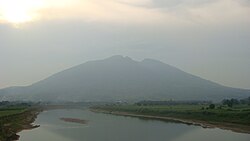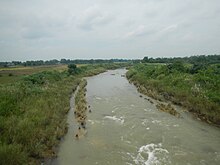
Pampanga, officially the Province of Pampanga, is a province in the Central Luzon region of the Philippines. Lying on the northern shore of Manila Bay, Pampanga is bordered by Tarlac to the north, Nueva Ecija to the northeast, Bulacan to the east, Manila Bay to the central-south, Bataan to the southwest and Zambales to the west. Its capital is the City of San Fernando. Angeles City is the largest LGU, but while geographically within Pampanga, it is classified as a first-class, highly urbanized city and has been governed independently of the province since it received its charter in 1964.

Nueva Ecija, officially the Province of Nueva Ecija, is a landlocked province in the Philippines located in the Central Luzon region. Its capital is the city of Palayan, while Cabanatuan, its former capital, is the largest local government unit (LGU). Nueva Ecija borders, from the south clockwise, Bulacan, Pampanga, Tarlac, Pangasinan, Nueva Vizcaya and Aurora. The province is nationally known as the Rice Granary of the Philippines, producing the largest rice yield in the country.

Central Luzon, designated as Region III, is an administrative region in the Philippines, primarily serving to organize the 7 provinces of the vast central plains of the island of Luzon, for administrative convenience. The region contains the largest plain in the country and produces most of the country's rice supply, earning itself the nickname "Rice Granary of the Philippines". Its provinces are: Aurora, Bataan, Bulacan, Nueva Ecija, Pampanga, Tarlac and Zambales. Pangasinan was formerly a province of Central Luzon before President Marcos signed Presidential Decree No. 1, 1972, incorporating it into Ilocos Region. Additionally, the province of Aurora was part of the defunct political region Southern Tagalog when the region was divided into Calabarzon and Mimaropa, upon the issuance of Executive Order No. 103, dated May 17, 2002, by then-President Gloria Macapagal Arroyo, which transferred Aurora to Central Luzon.

Gapan, officially the City of Gapan, is a 4th class component city in the province of Nueva Ecija, Philippines. According to the 2020 census, it has a population of 122,968 people.

San Antonio, officially the Municipality of San Antonio, is a 1st class municipality in the province of Nueva Ecija, Philippines. According to the 2020 census, it has a population of 83,060 people.
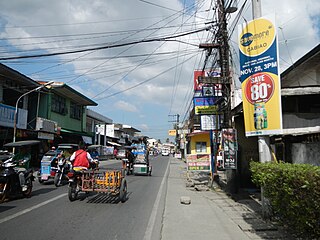
Cabiao, officially the Municipality of Cabiao, is a 1st class municipality in the province of Nueva Ecija, Philippines. According to the 2020 census, it has a population of 85,862 people. Cabiao is the 3rd most populous, one of the richest, and fastest growing municipality in the province, only behind Talavera and Guimba. If cities are included, the town ranks 6th.

Cabanatuan, officially the City of Cabanatuan, is a 1st class component city in the province of Nueva Ecija, Philippines. According to the 2020 census, it has a population of 327,325 people, making it the most populous city in Nueva Ecija and the fifth-most populous in Central Luzon.
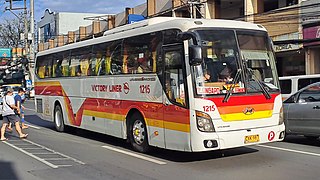
Victory Liner Inc. (VLI) is one of the largest provincial bus companies operating in the Philippines, servicing routes mainly to the provinces of Central Luzon which includes Zambales, Pampanga, Bulacan and Northern Luzon which includes Benguet, Pangasinan, Bataan, Nueva Vizcaya, Kalinga, Isabela and Cagayan. It was founded in 1945, when Chevy trucks from the United States Army used as their primary transportation fleet, it has grown to become one of the largest bus transportation business groups in the Philippines, servicing all key destinations in Northern and Central Luzon.

The North Luzon East Expressway (NLEE) is an under-construction four-lane, 92.1-kilometre (57.2 mi) long limited-access toll expressway in the Central Luzon region of the Philippines.

Baliwag Transit is the one of the major bus company in the Philippines with offices and terminals in various parts of Luzon that mainly services routes to and from Metro Manila and Central Luzon. It is named after the town of Baliwag, where it originated.

The Candaba Viaduct is a 5-kilometer (3.1 mi) viaduct carrying the North Luzon Expressway (NLEX) across the Candaba Swamp in the provinces of Bulacan and Pampanga, Philippines consisting of six lanes. In 1976, it surpassed the San Juanico Bridge to become the longest bridge in the Philippines. In 2022, it was surpassed by the 8.9 km Cebu–Cordova Link Expressway (CCLEX) and the viaduct is now the second longest bridge in the country. The viaduct was designed by Aas-Jakobsen and built by Construction Development Corporation of the Philippines as part of construction of the whole NLEX.
Felipe Salvador, also known as Apo Ipe or Ápûng Ipê Salvador, was a Filipino revolutionary who founded the Santa Iglesia, a messianic society that was categorized as "colorum" which had the aim of defeating and overthrowing the colonial government of the United States in the Philippines. Salvador joined the Katipunan in 1896 upon the arrival of the Katipuneros from Balintawak in Baliuag, Bulacan. He founded the Santa Iglesia in 1900 after fleeing to the mountains when Gen. Emilio Aguinaldo was captured by American troops. Salvador and his church gained a significant number of followers in the regions of Bulacan, Pampanga, Pangasinan, Tarlac and Nueva Ecija. He was captured by American forces in 1910. He was tried and sentenced to death, being hanged in 1912, two years after his capture.

Genesis Transport Service, Inc., also known as Genesis Transport or simply Genesis, is a provincial bus company in the Philippines, operating routes connecting Metro Manila to Central Luzon and Northern Luzon.
The first Cry of Nueva Ecija occurred on September 2–5, 1896, in the province of Nueva Ecija, in the Philippines under Spanish rule. It followed shortly after the Cry of Pugad Lawin and was the first call for revolution in central Luzon. Roughly 3,000 volunteers were led by Mariano Llanera and Pantaleon Valmonte. They marched towards San Isidro, the provincial capital, where after fighting several battles with the Spanish forces, their army was finally forced to retreat and to undertake guerrilla warfare.

First North Luzon Transit, Incorporated (FNLT), or simply known as First North Luzon is a bus company in the Philippines. They started their operations in Hagonoy, Bulacan, and expanded to San Isidro, Nueva Ecija, Bulacan, Pampanga, Bataan, Pangasinan and La Union. and soon to operate in Laoag, Vigan and Cagayan (including Aparri, Tuguegarao and Piat.
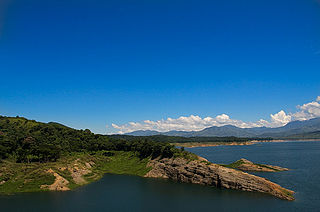
The Pantabangan–Carranglan Watershed Forest Reserve is a conservation area located in the upper reaches of the Pampanga River in Nueva Ecija, Philippines, and borders the Sierra Madre and Caraballo Mountains in Aurora and Nueva Vizcaya. It encompasses 84,500 hectares of the drainage basin surrounding the Pantabangan Lake, an impoundment of the Pampanga River by the Pantabangan Dam. The multi-purpose dam is situated at the confluence of Pampanga River's two headwaters, namely the Pantabangan and Carranglan Rivers in the municipality of Pantabangan. It stretches above the dam site for 21 kilometres (13 mi) to where Carranglan River originates in the Caraballo on the north, and for 18 kilometres (11 mi) to where Pantabangan River originates in the Sierra Madre on the east. It is considered a critical watershed for the agricultural economy and hydroelectric power generation in the region of Central Luzon.

Jose Abad Santos Avenue (JASA), also known as the Olongapo–Gapan Road and the Gapan–San Fernando–Olongapo Road, is a two-to-thirteen-lane 118-kilometer (73 mi) major highway spanning the provinces of Bataan, Nueva Ecija, Pampanga, and Zambales in Central Luzon, Philippines. The highway is designated as National Route 3 (N3) of the Philippine highway network.
Juan Feleo was a Filipino peasant leader and politician. He was one of the founders of one of the Philippines' leading peasant groups, the Kalipunang Pambansa ng Magbubukid sa Pilipinas and a top-ranking member of the Partido Komunista ng Pilipinas. He was also involved in the HUKBALAHAP, and his death sparked the subsequent Huk Rebellion.
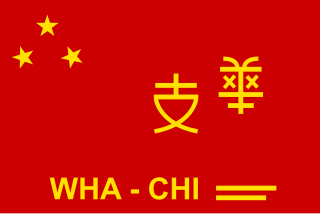
The Wha Chi, also known as the Philippine-Chinese Anti-Japanese Guerrilla Forces, is a Chinese Filipino guerrilla group which fought against invading Imperial Japanese forces which occupied the Philippines during the World War II era.
